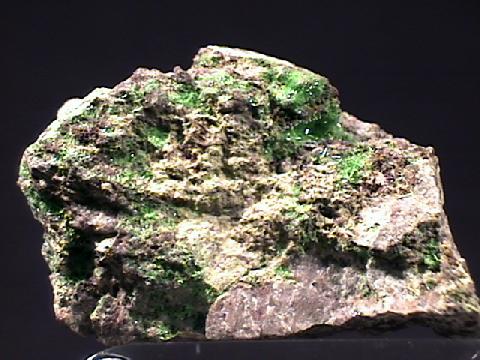
CUPROSKLODOWSKITE
Specimen csk-1
$ 35.00
Dims: 1.9" x 1.3" x 1.2" (4.8 x 3.3 x 3.0 cm)
Wt: 1.46 oz. (41.7 g)
Musonie Mine, Zaire
Dozens of tiny Cuprosklodowskite needles rest in hollows on the yellow-and-brown host rock of this specimen. The largest of these needles measures about 0.2" (5 mm) in length and its other dimensions each measure less than 1 mm, so it is impossible to study their triclinic form without magnification. They have a bright, lime-green coloration and even with their tiny size, appear to be only translucent. Their luster is pearly. Along with the Cuprosklodowskite are some very weathered patches of a dark green mineral; I suppose that it could either be torbernite or malachite. The brown host rock is mottled with dull yellow patches of a weathered uranium mineral that is probably sklodowskite.
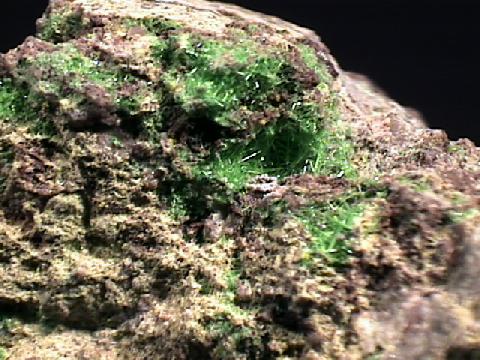
 Amethyst Galleries' Mineral Gallery MINERALS |

CUPROSKLODOWSKITE specimen csk-1
$ 35.00
$ 35.00
Dims: 1.9" x 1.3" x 1.2" (4.8 x 3.3 x 3.0 cm)
Wt: 1.46 oz. (41.7 g)
Musonie Mine, Zaire
Dozens of tiny Cuprosklodowskite needles rest in hollows on the yellow-and-brown host rock of this specimen. The largest of these needles measures about 0.2" (5 mm) in length and its other dimensions each measure less than 1 mm, so it is impossible to study their triclinic form without magnification. They have a bright, lime-green coloration and even with their tiny size, appear to be only translucent. Their luster is pearly. Along with the Cuprosklodowskite are some very weathered patches of a dark green mineral; I suppose that it could either be torbernite or malachite. The brown host rock is mottled with dull yellow patches of a weathered uranium mineral that is probably sklodowskite.


csk-1 ($ 35.00)
Musonie Mine, Zaire
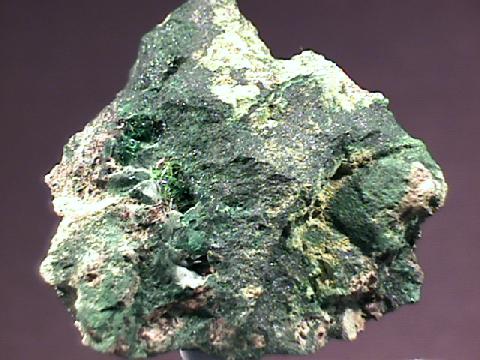
CUPROSKLODOWSKITE specimen csk-2
$ 35.00
$ 35.00
Dims: 2.0" x 1.9" x 1.0" (5.1 x 4.8 x 2.5 cm)
Wt: 2.18 oz. (62.0 g)
Musonie Mine, Zaire
Cuprosklodowskite crystals line 3 small pockets on this large thumbnail specimen. They do not exceed 0.2" (5 mm) in length and are only slightly thicker than human hair. Unlike most of the uranium minerals that I have seen, these needles appear to be at least dimly transparent, and they have a generally deeper color than most other Cuprosklodowskite specimens that I have seen. Their luster is pearly and their color ranges from a pale yellow-green to a deep green. The host rock in which they rest is rather interesting in its own right, as there are copper-bearing minerals, uranium-bearing minerals, and minerals that contain both all mixed together in close proximity. There large, pale yellow patches of decayed Sklodowskite and possibly other uranium minerals, patches of densely-packed Cuprosklodowskite needles that appear nearly massive in form, and even the metallic luster of cuprite is visible in one area! Though I have not tested it, I would imagine that this specimen will cause a substantial reading on a radiation meter.
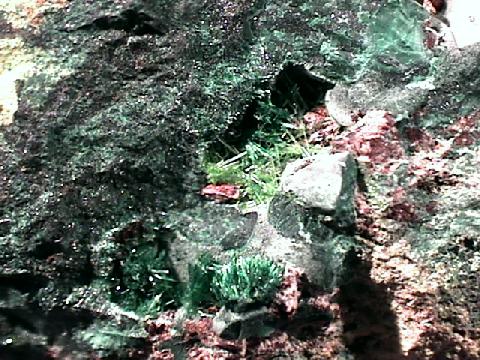

csk-2 ($ 35.00)
Musonie Mine, Zaire
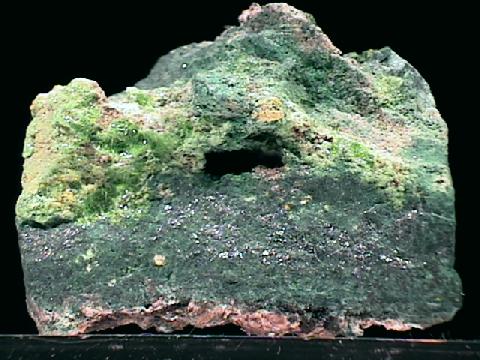
CUPROSKLODOWSKITE specimen csk-3
$ 55.00
$ 55.00
Dims: 1.7 x 1.5 x 1.4" (4.3 x 3.8 x 3.6 cm)
Wt: 2.54 oz. (72.2 g)
Musonie Mine, Shaba Province, Zaire
This large thumbnail specimen consists of several patches of fine Cuprosklodowskite needles that rest in a dark green, copper-bearing base rock. These needles do not exceed 0.2" (0.4 cm) in length and are considerably thinner than 1 mm in diameter. Patches of the material have been crushed, but those that rest in hollows are intact and in excellent condition. Though they are too thin for me to effectively study, their triclinic form is likely very good. All have a bright yellow-green color and a pearly luster, and appear to be transparent. The host rock in which they rest is made up of a variety of copper minerals, including malachite and cuprite, and possibly some torbernite.
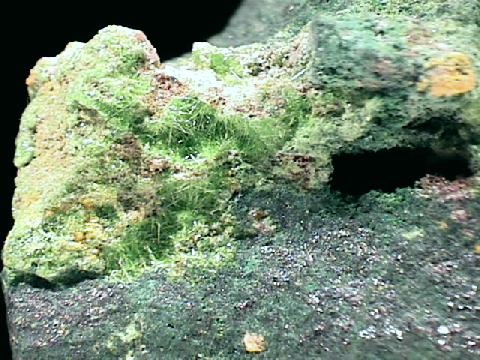

csk-3 ($ 55.00)
Musonie Mine, Shaba Province, Zaire
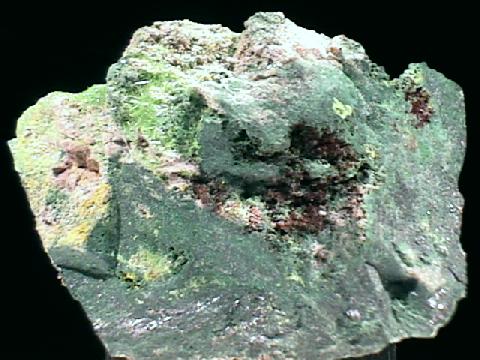
CUPROSKLODOWSKITE specimen csk-4
$ 60.00
$ 60.00
Dims: 2.4 x 1.5 x 1.3" (6.1 x 3.8 x 3.3 cm)
Wt: 2.98 oz. (84.5 g)
Musonoie Mine, Shaba Province, Zaire
Two patches of fibrous Cuprosklodowskite rest on the copper-bearing base of this specimen. These patches are each made up of scores of randomly arranged Cuprosklodowskite needles that appear to be in good condition. They generally do not exceed 0.1" (3 mm) in length, though a few may be as long as 0.2" (5 mm). They are too fine for me to effectively study their triclinic form, but it is likely good. All have a bright green-yellow coloration and a pearly luster, and appear to be individually transparent. The base rock on which they rest is likely made up of malachite and cuprite and may contain small amounts of sklodowskite and torbernite.
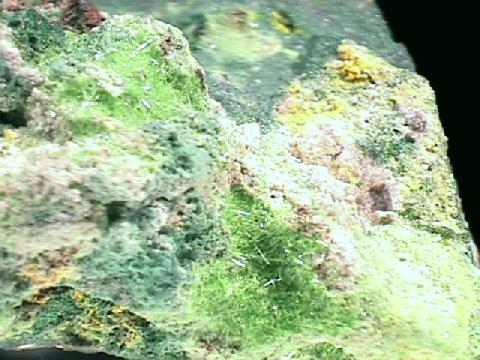

csk-4 ($ 60.00)
Musonoie Mine, Shaba Province, Zaire
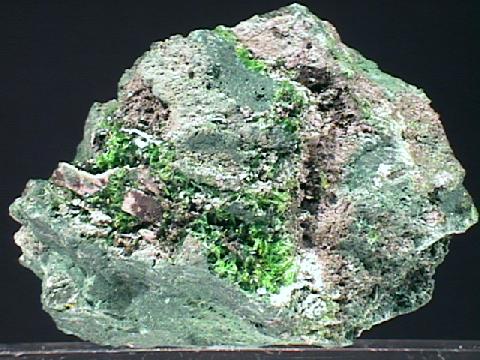
CUPROSKLODOWSKITE specimen csk-5
$ 60.00
$ 60.00
Dims: 2.5 x 1.9 x 1.5" (6.4 x 4.8 x 3.8 cm)
Wt: 4.74 oz. (134.3 g)
Musonoie Mine, Shaba Province, Zaire
Several flat clusters of radiating Cuprosklodowskite needles lie in veins that extend through the copper-bearing host of this specimen. The needle-like crystals that make up these clusters do not exceed 0.3" (7 mm) and are generally in good condition, as they are not very much exposed. All are too thin for me to effectively study their triclinic form, but it is likely good. They have a coloration that ranges from pale yellow-green to grass-green and a pearly luster, and are generally transparent. They are accompanied in some crevices by tiny torbernite blades, and some of the crystals appear to fade to a bright yellow coloration at their tips, denoting sklodowskite! The host material is made primarily of malachite, and may contain a substantial amount of cuprite.
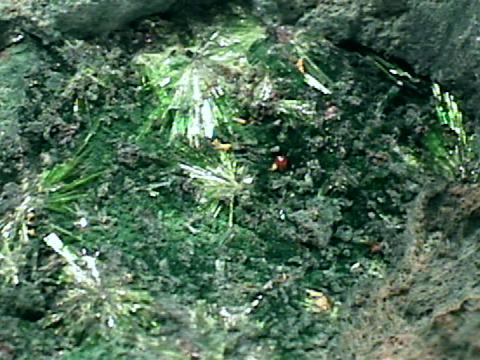

csk-5 ($ 60.00)
Musonoie Mine, Shaba Province, Zaire
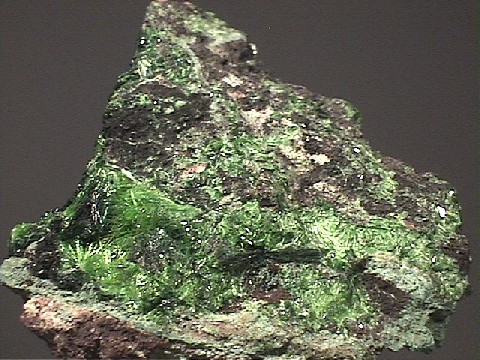
CUPROSKLODOWSKITE specimen csk-6
$ 180.00
$ 180.00
Dims: 1.7x1.8x1.0" (4.4x4.5x2.5 cm)
Wt: 1.70 oz. (48 g)
Musonoi Mine, Katanga Proirng, Congo
This is a beautiful specimen of cuprosklowdowskite, showing the bright green color and radiating acicular crystals of the species. Under a loupe, the individual crystals are a transparent pale green that appears a dark green in the aggregate. The crystals are large enough to be visible to the naked eye. This specimen appears to have veins of cuprosklowdowskite running all the way through the specimen, so there is a lot of it here. This specimen is consequently very radioactive, and should be stored under glass and/or a plastic dome (which will easily stop the alpha particle radiation), and handling should be minimized.


csk-6 ($180.00)
Musonoi Mine, Katanga Proirng, Congo